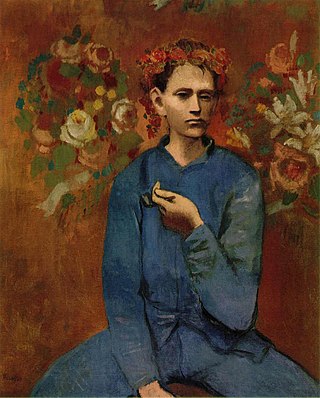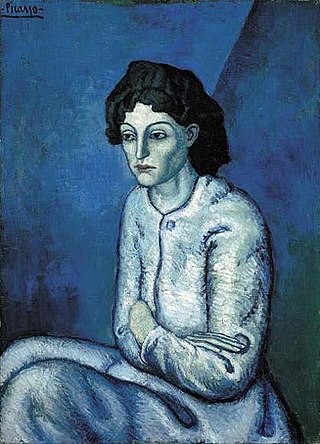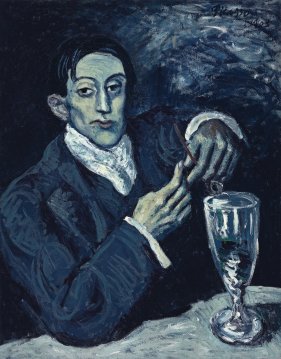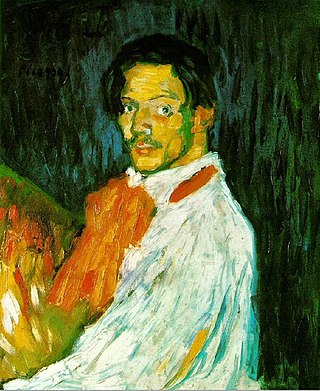
Pablo Ruiz Picasso was a Spanish painter, sculptor, printmaker, ceramicist, and theatre designer who spent most of his adult life in France. One of the most influential artists of the 20th century, he is known for co-founding the Cubist movement, the invention of constructed sculpture, the co-invention of collage, and for the wide variety of styles that he helped develop and explore. Among his most famous works are the proto-Cubist Les Demoiselles d'Avignon (1907) and the anti-war painting Guernica (1937), a dramatic portrayal of the bombing of Guernica by German and Italian air forces during the Spanish Civil War.

Garçon à la Pipe is an oil on canvas painting by Pablo Picasso. It was painted in 1905 when Picasso was 24 years old, during his Rose Period, soon after he settled in the Montmartre area of Paris. The painting depicts a Parisian adolescent boy who holds a pipe in his left hand and wears a garland of flowers on his head, surrounded by two floral decorations. The subject was a local boy named "P’tit Louis" who died at a young age. The painting is listed as one of the most expensive paintings, after being sold at Sotheby's auction for $104 million on 5 May 2004. It is currently the fifth highest selling painting by Picasso.
The Blue Period comprises the works produced by Spanish painter Pablo Picasso between 1901 and 1904. During this time, Picasso painted essentially monochromatic paintings in shades of blue and blue-green, only occasionally warmed by other colors. These sombre works, inspired by Spain and painted in Barcelona and Paris, are now some of his most popular works, although he had difficulty selling them at the time.

Femme aux Bras Croisés, is an oil on canvas painting by Pablo Picasso, which he created between 1901 and 1902 during his Blue Period. The subject of the painting is unknown, but she is considered to be an inmate of the Saint-Lazare hospital-prison in Paris. The painting is listed as one of the most expensive paintings after it achieved a price of $55 million at Christie's auction on 8 November 2000.

Ambroise Vollard was a French art dealer who is regarded as one of the most important dealers in French contemporary art at the beginning of the twentieth century. He is credited with being a major supporter and champion of the contemporary artists of his period, providing exposure and emotional support to numerous then-unknown artists, including Paul Cézanne, Aristide Maillol, Pierre-Auguste Renoir, Louis Valtat, Pablo Picasso, André Derain, Georges Rouault, Paul Gauguin, and Vincent van Gogh.

Jeune garçon au cheval is an oil on canvas painting by Pablo Picasso. The painting is housed in the Museum of Modern Art in New York. It was painted in Picasso's Rose Period from 1905 to 1906, when he was still a struggling artist living in Paris. The painting is a study for a much larger composition that Picasso never completed.

Oviri is an 1894 ceramic sculpture by the French artist Paul Gauguin. In Tahitian mythology, Oviri was the goddess of mourning and is shown with long pale hair and wild eyes, smothering a wolf with her feet while clutching a cub in her arms. Art historians have presented multiple interpretations—usually that Gauguin intended it as an epithet to reinforce his self-image as a "civilised savage". Tahitian goddesses of her era had passed from folk memory by 1894, yet Gauguin romanticises the island's past as he reaches towards more ancient sources, including an Assyrian relief of a "master of animals" type, and Majapahit mummies. Other possible influences include preserved skulls from the Marquesas Islands, figures found at Borobudur, and a 9th-century Mahayana Buddhist temple in central Java.

Portrait of Angel Fernández de Soto is a portrait by Spanish artist Pablo Picasso completed in 1903 during his Blue Period. The oil painting depicts Picasso's friend and fellow painter, Angel Fernandez de Soto, in a bar with a glass of absinthe. The painting was previously owned by musical theatre composer Andrew Lloyd Webber. On 23 June 2010, the painting was sold at auction for £34.7 million.

La Lecture is a painting by Spanish artist Pablo Picasso completed in January 1932. The oil painting depicts Picasso's mistress and muse, Marie-Thérèse Walter, asleep with a book upon her lap. The painting led to the breakup of Picasso's marriage to Olga Khokhlova after she saw it at a retrospective exhibition and realised that the facial features were not her own. The painting went to auction in 1989 and in 1996, where it failed to sell. In January 2011, it was announced that La Lecture would be going to auction on 8 February. The painting, which had not been seen in Europe since the exhibition, was then displayed at Sotheby's in Paris.

Child with a Dove, also described as Child Holding a Dove, Child with a Pigeon is an oil-on-canvas painting by the Spanish artist Pablo Picasso, which he created in 1901 at the start of his Blue Period. The painting is a depiction of a young girl in a white dress holding a white dove, and represents an important transitional moment in the artist’s career. It was on public display at the National Gallery in London, England for nearly four decades before its private sale in 2012, when it achieved a price of £50 million.

The Blue Room is a 1901 oil on canvas painting by Pablo Picasso, which he painted during his Blue Period. It depicts a scene of a nude woman bending over in a bath tub. A hidden painting was revealed beneath the surface by x-ray images and infra-red scans, showing a portrait of a bearded man. The painting has been housed in The Phillips Collection, in Washington D.C. since 1927.
Woman Ironing is a 1904 oil painting by Pablo Picasso that was completed during the artist's Blue Period (1901—1904). This evocative image, painted in neutral tones of blue and gray, depicts an emaciated woman with hollowed eyes, sunken cheeks, and bent form, as she presses down on an iron with all her will. A recurrent subject matter for Picasso during this time is the desolation of social outsiders. This painting, as the rest of his works of the Blue Period, is inspired by his life in Spain but was painted in Paris.

Au Lapin Agile is a 1905 oil on canvas painting by Pablo Picasso. It depicts the interior of the Lapin Agile, a famous cabaret club in the Montmartre area of Paris. The composition was produced during Picasso's Rose Period and includes a self-portrait of the artist who frequented the club in his youth. The painting is listed as one of the most expensive paintings after achieving a price of $40.7 million at Sotheby's auction on 27 November 1989. It is housed in the collection of the Metropolitan Museum of Art in New York City.

Yo, Picasso, is an oil-on-canvas painting by Pablo Picasso, which he painted in 1901. It is a self-portrait of the artist that depicts him in his youth, aged 19. The painting was created at the beginning of Picasso's Blue Period. On 9 May 1989, the painting sold at Sotheby's, achieving a price of $47.85 million, making it one of the most expensive paintings sold up to that date.

Young Girl with a Flower Basket is a 1905 oil on canvas painting by Pablo Picasso from his Rose Period. The painting depicts a Parisian street girl, named "Linda", whose fate is unknown. It was painted at a key phase in Picasso's life, as he made the transition from an impoverished bohemian at the start of 1905 to a successful artist by the end of 1906. The painting is listed as one of the most expensive paintings, after achieving a price of $115 million when it was sold at Christie's on 8 May 2018. It is currently the fourth highest selling painting by Picasso.

Portrait of Ambroise Vollard is an oil-on-canvas painting by Pablo Picasso, which he painted in 1910. It is now housed in the Pushkin Museum in Moscow. The painting is a representation of the influential art dealer Ambroise Vollard, who played an important role in Picasso's early career as an artist. It is painted in the style of Analytical Cubism, which Picasso pioneered.

Le Repos is an oil-on-canvas painting created by Pablo Picasso in 1932. It depicts a portrait of Marie-Thérèse Walter, the artist's lover and muse, in a sleeping pose. The painting was produced in the midst of their relationship and is a demonstration of Picasso's love for his mistress. Le Repos was one of a series of sleeping portraits of Walter that Picasso created in 1932. On 14 May 2018, the painting achieved a value of $36.9 million when it was sold at Sotheby's auction.

Femme au béret et à la robe quadrillée is an oil-on-canvas painting by Pablo Picasso, which he created in 1937. It is a portrait of Marie-Thérèse Walter, Picasso's lover and muse during this period and was created with elements of Cubism. The painting signifies a transition in their relationship by combining Walter's profile with that of Picasso's new lover, the Surrealist photographer Dora Maar, with whom he began a relationship in 1936. This portrait was produced in the same year as Guernica and The Weeping Woman, a significant phase in Picasso's artistic career. On 28 February 2018, it was sold at Sotheby's auction for £49.8 million, making it one of the most expensive paintings ever sold at an auction in Europe.
Femme à la montre is a 1932 oil-on-canvas portrait by Pablo Picasso of his muse Marie-Thérèse Walter. Painted during Picasso's annus mirabilis, the work depicts Walter sitting upright in an armchair.


















